Earth's Magnetic Field and Wandering Poles

Imagine a bar magnet inside Earth, more or less aligned with the axis, where the ends of that magnet lie close to the geographic North and South poles of the planet. The magnetic field lines travel from the north pole of the magnet, looping back around to go back in toward the south pole. At each pole, the magnetic field lines are nearly vertical.
While there is definitely not a magnetic bar inside Earth, the same phenomenon occurs around the Earth, creating a protective area around the entire planet called the magnetosphere, according to NASA. Earth's magnetosphere protects us from harmful cosmic radiation and solar wind and is responsible for the beautiful auroral displays seen at the high latitudes of the Northern and Southern hemispheres.
Earth's magnetic and geographic poles are situated opposite of one another. In other words, Earth's magnetic south pole is actually near the geographic North Pole. So when we use a compass to determine our location, the compass needle actually points toward the south magnetic pole when in the Northern Hemisphere and toward the north magnetic pole in the Southern Hemisphere.
The magnetic poles aren't fixed and wander a bit across the surface of the planet with respect to the geographic poles. About 75 percent of the intensity of Earth's magnetic field is represented by the "magnetic bar." The other 25 percent of the intensity of Earth's magnetic field, which can be thought of as smaller bar magnets that are moving around, comes from smaller portions of moving magma and may be what allows the poles to move.
Based on data released by the National Centers for Environmental Information in February 2019, the magnetic north pole is located at 86.54 N 170.88 E, within the Arctic Ocean and heading from Canada toward Siberia. The magnetic south pole is located at 64.13 S 136.02 E, just off the coast of Antarctica in the direction of Australia.
Where does the field come from?
While still a bit of a mystery, scientists generally agree that the magnetic field of the Earth starts deep in the core of the planet. The outer core of the planet is made up of molten metals, primarily iron, which is a conductor.
"Churning, molten metal in the outer core generates the [magnetic] field by what is known as dynamo action," said Aleksey Smirnov, a geophysics professor at Michigan Technological University.
Dynamo action, or the dynamo theory, describes the way a planet can sustain a magnetic field. The dynamo, or source of the magnetic field, is created by a rotating, convecting and electrically conducting material, such as the molten iron inside the Earth.
"There are a lot of ionized atoms and free electrons roaming around, plus there is a complex form of convection going on in the interior, combined with Earth's natural rotation — there are a lot of moving charges," said Doug Ingram, a physics and astronomy professor at Texas Christian University.
Scientists believe that the charges created by the moving metallic material move around Earth's equatorial region in a circular motion which generates the north and south magnetic poles at the surface, said Ingram.

Why do the poles move?
Earth's dynamo is persistent, but unstable. Right now, the magnetic field is rapidly changing, with the magnetic north pole making a sudden jump toward Siberia. Since the 1990s, the magnetic north pole has shifted about 35 miles (55 km) per year, on average, according to a 2019 study published in the journal Nature.
Disturbances in the flowing, metallic magma might be the cause of the instabilities in the magnetic field which may lead to such pole shifts, according to Smirnov. The movement of the liquid iron deep under Canada may slightly weaken the magnetic field in that location, which is what's allowing the north magnetic pole to move toward Siberia, the Nature article states.
Other electromagnetic anomalies can be seen all over the world, such as in southern Africa where a magnetic field disturbance, similar to an eddy in a stream, may be caused by a denser portion of the mantle near the boundary with the planet's liquid outer core.
History of pole shifting and reversal
While the poles are constantly shifting, they have also completely reversed at least a few hundred times within the last 3 billion years, according to NASA. During this process, which typically occurs every 200,000 to 300,000 years over the course of 100 to a few thousand years at a time, the magnetic field becomes squashed and pulled with multiple poles sprouting up randomly over the surface of the Earth. The last full reversal occurred about 780,000 years ago.
The history of the magnetic field, including shifts and reversals, is evidenced in the geologic record. Metals found in rocks, including iron, align with the magnetic field before molten rocks solidify or as fragments that contain the magnetic metals aligned with the magnetic field and settle in layers of sedimentary rocks.
"Since the Earth is a dynamic and ever-changing place, new rocks, and their magnetic records, have been generated constantly throughout geologic time," Smirnov said, adding that these records can be preserved for millions or billions of years.
Similar records are found on the floor of the Atlantic Ocean where new seafloor is constantly being created at the mid-Atlantic ridge.
"As the lava wells up to the surface [through the long crack that makes up the ridge], it is molten, and the iron particles suspended in the lava orient themselves in the direction of Earth's prevailing magnetic field," Ingram said. As the lava solidifies, it locks the metal deposits in place, and thus, creates a historic record of the shifts and reversals of Earth's magnetic field.
What do these wandering and flipping poles mean for life on our planet? There are no drastic changes present in the fossil record for either plant or animal life during both shifts and reversals, according to NASA, which suggests that the effects of pole reversal on life are minimal. Although, there is some speculation among scientists that during periods of decreased magnetic field strength, more cosmic radiation could have reached Earth's surface and caused an increased rate of genetic mutation and therefore, gave evolution a boost, Smirnov said.
Additional resources:
- Watch this cool visualization of Earth's magnetosphere from NASA's Scientific Visualization Lab.
- Learn about NASA's Magnetospheric Multiscale mission to understand how the magnetic fields around Earth connect and disconnect.
- Check out these maps of the historical locations of the wandering magnetic poles from the National Centers for Environmental Information.
Sign up for the Live Science daily newsletter now
Get the world’s most fascinating discoveries delivered straight to your inbox.

Rachel Ross is a science writer and editor focusing on astronomy, Earth science, physical science and math. She holds a Bachelor of Arts in Philosophy from the University of California Davis and a Master's degree in astronomy from James Cook University. She also has a certificate in science writing from Stanford University. Prior to becoming a science writer, Rachel worked at the Las Cumbres Observatory in California, where she specialized in education and outreach, supplemented with science research and telescope operations. While studying for her undergraduate degree, Rachel also taught an introduction to astronomy lab and worked with a research astronomer.










